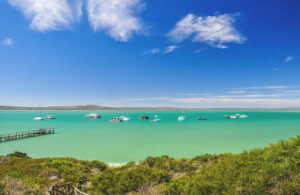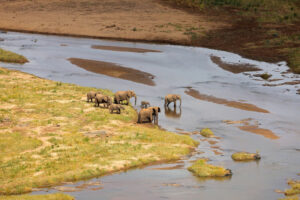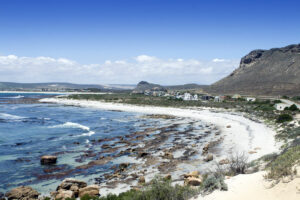
Langebaan Lagoon. Image: Shutterstock
Coastal mining along the West Coast is expanding at an alarming rate, increasingly threatening the environment and livelihoods of small-scale fisheries and coastal communities.
Currently there are many different companies that have applied for or been allocated permits and right for oil and gas exploration as well as prospecting or mining on coastal land, the beaches, in the near-shore and off-shore marine waters.
What sort of mining is being undertaken along our coast?
Diamond mining on the coast has a long history in the Northern Cape. While some mining for diamonds has been ongoing on the West Coast since the 80’s, over the last 10 years, there has been an increase in heavy mineral sand mining north of the Olifants Estuary.

Image: United Nations Development Programme (UNDP)
The last 2 years has seen a significant increase in the number of applications for heavy mineral sands, gemstones, diamond mining, including coffer dam mining, as well as phosphates extending as far south as Elandsbaai. In addition, there are off-shore diamond prospecting rights, oil and gas exploration permits and off-shore oil and gas drilling rights.
Who is making the decisions about all these prospecting and mining applications?
All applications for prospecting, exploration and mining are assessed and approved by the Department of Minerals and Energy (DMRE). The management and protection of South Africa’s environment, including applications to use and develop both the coastal land, beaches, surf and off-shore is governed by the National Environmental Management Act (NEMA) of 1998. Any person, company or entity wanting to undertake prospecting or mining activities must apply for environmental authorisation (EA) in terms of NEMA.

A small herd of African elephants crosses the Olifants River, Kruger National Park. Image: Alamy
They are required to follow the NEMA Environmental Impact Assessment (EIA) regulations and prepare either a Basic Assessment or EIA Report to guide decision-making. They therefore apply to the DMRE for a permit but must receive environmental authorisation in terms of NEMA. The DMRE is approving all these applications. Currently approvals for prospecting and mining are being granted in Critical Biodiversity Areas, in important fishing areas for small-scale and commercial fisheries, on agricultural land, on pristine beaches and areas of cultural importance.
Does coastal mining have negative impacts on our coastal and marine environment?
Each prospecting or mining application must include an assessment of the impacts of that activity. Impacts are assessed and rated by specialists who also suggest mitigation measures to reduce the impacts. One of the key problems is that the DMRE looks at each individual project rather than assessing what the combined impacts of several different different projects might be on an area.
Specialists are meant to consider the cumulative impacts of a project, which refers to the impacts of the current project taken together with impacts associated with other past, present and future projects in the area. Also, the monitoring of projects once approved is done by the DMRE not the Department of Fisheries, Forestry and the Environment (DFFE), even though the DFFE is responsible for protecting and managing the environment.

Elands Bay. Image: Alamy
This is a huge weakness and gap in the way in which our environmental legislation is being implemented: no one authority has a bird’s eye view of what is happening on our coastline. Another main concern is that small-scale fishers and local communities are often not properly consulted about these prospecting and mining projects and their local and traditional knowledge of the coast, their cultural heritage and natural resources, is not included in the assessment.
What can we do to protect our coast from the negative impacts of mining?
Our Environmental Impact Assessment (EIA) regulations require that interested and affected persons must be consulted in a meaningful way. Each application must consider all potential impacts such as loss of cultural heritage, livelihoods and biodiversity.
Where an area is under development pressure, such as on the West Coast, the DFFE can require use of other assessment tools such as a Strategic Environmental Assessment (SEA) or an Environmental Management Framework (EMF), to guide planning and decision-making for that area. In this way, a collective vision for the area can be formulated, environmental opportunities and constraints can be identified and sustainability targets set. This will assist in development activities that are appropriate and do not impact on the environment and communities in a negative way. Such a strategic assessment and plan must be done for the West Coast.
Any interested or affected person such as a fisher or coastal resident, has the right to request to be informed and consulted about an application. In addition, they have the right to appeal any decision that is taken. The Minister of Fisheries, Forestry and the Environment is the appeal authority for all prospecting and mining applications.
Know your rights!
Participate in EIA processes, demand that no new applications for mining be approved until an SEA or EMF has been developed for the West Coast. This must be done through a participatory process that is inclusive of all stakeholders and rights holders.
Article created by:



Leave a Reply or Follow